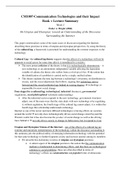Summary
CM1007 Summary - Communication Technologies and their Impact @EUR
- Course
- Institution
The document includes a concise summary of all the articles, digital lectures, and Canvas material from weeks 1 to 8 required in preparation for the exam of the course Communication Technologies and their Impact. Namely, the following articles are summarized: Week 1 - Fisher & Wright (2006) - O...
[Show more]



